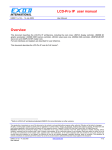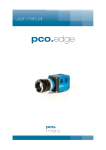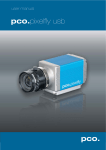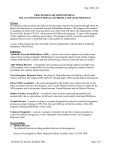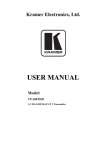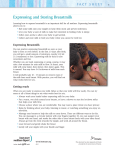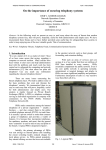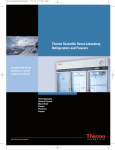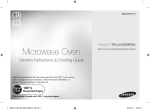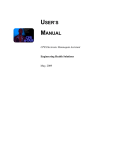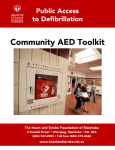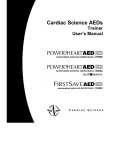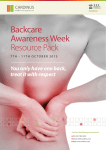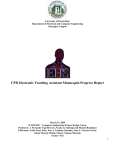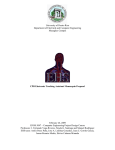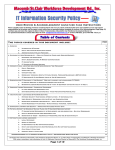Download how to start an AED program - Heart and Stroke Foundation of Canada
Transcript
SECTION 1 | Overview Heart and Stroke Foundation AED Program YOUR GUIDE TO SAVING LIVES Automated External Defibrillator Program Toolkit 1 HEALTHY LIVES FREE OF HEART DISEASE AND STROKE. TOGETHER WE WILL MAKE IT HAPPEN. The Heart and Stroke Foundation is asking all Canadians to Make Health Last by taking action today to give themselves, their friends and families longer, healthier, fuller lives. Take the Heart and Stroke risk assessment today at www.makehealthlast.ca. No portion of this document may be reproduced or copied without written permission from: Heart and Stroke Foundation of Canada Ottawa, Ontario Heart and Stroke Foundation of Canada assumes no responsibility or liability arising from any error in or omission from this publication, or from the use of any information or advice it contains. Heart and Stroke Foundation of Canada is dedicated to serving you. If you have any questions about heart disease or stroke, please call Heart and Stroke Foundation of Canada toll-free at 1-877-473-0333 — or visit our website, www.heartandstroke.ca. © Heart and Stroke Foundation of Canada, 2013 SECTION 1 | Overview Heart and Stroke Foundation AED Program TABLE OF CONTENTS Section 1: Overview 04 Introduction 05 Aim of the Toolkit 05 Questions About the Program or Toolkit 05 Section 2: Using Your AED 06 Defining Sudden Cardiac Arrest 07 Treating Sudden Cardiac Arrest 08 Using Your AED 09 Good Samaritan Protection 09 Section 3: Managing Your AED 10 Selecting Your AED 11 AED Costs 11 AED Training and Support 12 Installing Your AED 13 Registering Your AED 14 Promoting Your AED 14 Maintaining Your AED 15 After Your AED Is Used 15 AED Management Plan 17 Appendices 18 Glossary of Terms 19 The Chain of SurvivalTM 20 AED Purchase Checklist 21 AED Maintenance Checklist 22 3 SECTION 1 Overview • Introduction • Aim of the Toolkit • Questions About the Program or the Toolkit SECTION 1 | Overview Heart and Stroke Foundation AED Program INTRODUCTION NHL hockey player Brett MacLean, 23, was revived by an AED, when he suffered a cardiac arrest at a pick-up hockey game. “The AED saved my life, and it’s important for people to be trained,” said MacLean. “You never know when you might need it; it could happen to anyone, anywhere.” Welcome to the Heart and Stroke Foundation Automated External Defibrillator (AED) Program. Thank you for partnering with the Heart and Stroke Foundation (HSF) to help Make Health Last and save the lives of Canadians. We can save more lives, if we act. Thanks to your ongoing commitment, we are helping Canadians save lives. Up to 40,000 sudden cardiac arrests occur in Canada annually – that’s one about every 12 minutes. Most cardiac arrests occur in homes and public places, and many are witnessed by a family member, co-worker or friend. Performing CPR (cardiopulmonary resuscitation) and using an AED before emergency medical services arrive can increase the chance of survival by 75 per cent. Healthy lives free of heart disease and stroke. Together we will make it happen. The Heart and Stroke Foundation is asking all Canadians to Make Health Last by taking action today to give themselves, their friends and families longer, healthier, fuller lives. Take the Heart and Stroke risk assessment today at makehealthlast.ca. AEDs are electronic devices used to restart a person’s heart that has stopped beating. They are safe, easy to use, and can be operated effectively by the public. CPR can help restore blood flow to someone suffering cardiac arrest for a short time until advanced medical care arrives. AIM OF THE TOOLKIT This practical toolkit is designed specifically to address the many questions faced by organizations considering the acquisition of AEDs. It includes: The Foundation, with partners, trains approximately 1.6 million people every year in CPR and AED use. Our goal is for every Canadian to learn CPR and to know how to use an AED in the event of a sudden cardiac arrest so they can take action when the need arises. • Information about sudden cardiac arrest (SCA) and AEDs. • A n AED placement model that offers step-by-step guidance. • Information on the maintenance and use of an AED. In April 2011,the HSF secured the Government of Canada’s commitment of $10 million towards the placement of life-saving AEDs in public hockey arenas and community recreation centres across Canada. Through the HSF AED Program, we are coordinating AED installation and staff training in these facilities across Canada. QUESTIONS ABOUT THE PROGRAM OR TOOLKIT Please feel free to contact the Heart and Stroke Foundation with any questions you may have in regard to the HSF AED Program and/or this toolkit. This investment will ensure more public spaces coast to coast are equipped with these life-saving devices – devices that are safe, easy to use and make the odds of surviving a cardiac arrest skyrocket. • Telephone: 1-877-473-0333 • Email: [email protected] • Website: www.heartandstroke.ca 5 SECTION 2 Using Your AED • Defining Sudden Cardiac Arrest • Treating Sudden Cardiac Arrest Using Your AED • Using Your AED • Good Samaritan Protection SECTION 2 | Using Your AED Heart and Stroke Foundation AED Program DEFINING SUDDEN CARDIAC ARREST SUDDEN CARDIAC ARREST Sudden cardiac arrest (SCA) occurs when a person’s heart stops functioning properly. It can strike anyone, anywhere, anytime. It usually happens in the home, workplace or community — away from the advanced life support available in a hospital. • Is caused by an abnormal heart rhythm (in most cases ventricular fibrillation). • Is caused by a blockage in an artery that supplies blood to the heart. • Is always sudden. • Causes heart muscle to die due to lack of oxygen. • Has no warning signs. • Causes a person to lose consciousness. Sudden cardiac arrest is NOT a heart attack. Signs of Sudden Cardiac Arrest: When a person has a heart attack, the blood supply to the heart is slowed or stopped due to a blockage. In cardiac arrest, however, a person’s heart stops functioning with little or no warning. • Sudden collapse. • Sudden unresponsiveness to touch or sound. • Breathing has stopped or is abnormal. Sudden cardiac arrest occurs up to 40,000 times each year in Canada and is a major cause of death. Cardiac arrest happens without warning, and there are often no symptoms; it can even kill healthy children and teens. HEART ATTACK • Is preventable. • The person is typically awake and alert. Signs of Heart Attack: • Chest discomfort (uncomfortable chest pressure, squeezing, fullness or pain, burning or heaviness). • Discomfort in other areas of the upper body (i.e., neck, jaw, shoulder, arms, back). • Shortness of breath. • Sweating. • Nausea. • Light-headedness. A cardiac arrest is a failure of the heart’s electrical system. All cardiac arrest victims will die unless they receive emergency medical help. Time is critical. Without immediate treatment, the victim will suffer brain damage within 3 minutes and will rarely survive past 12 minutes. An AED is a portable, safe and easy-to-use device for assessing and restarting the heart. The AED reads the heart rhythm and only delivers a shock if needed. The electric shock it delivers can correct a heart that is not functioning properly. The AED can’t do harm and will not shock someone unnecessarily. 3 minutes without treatment will likely result in brain damage. The placement of AEDs in public arenas and recreational facilities equips Canadians with a tool that saves lives. 12 minutes without treatment will likely result in death. 7 TREATING SUDDEN CARDIAC ARREST Call 911! CPR Immediately! AED as soon as possible! When a person is in cardiac arrest, the only way to correct the electrical rhythm of his or her heart is with an electric shock from an AED. That shock will cause the heart to resume its natural rhythm. Often an AED is located a few minutes away from the person in cardiac arrest, so someone will have to retrieve it. Meanwhile, call 9-1-1 (or your emergency response number) and start CPR immediately. An AED should be used as soon as it is available. Although CPR cannot restart the heart, it can help to support circulation and ventilation in a person suffering cardiac arrest. The pumping action pushes blood and oxygen to the brain and other vital organs in the body, allowing them to continue functioning for a short period of time until an AED arrives. CPR alone is not enough; it is best combined with defibrillation. Performing CPR alone has a 5% survival rate, but that rate can reach up to 75% when CPR is coupled with an AED in the first few minutes. SECTION 2 | Using Your AED Heart and Stroke Foundation AED Program USING YOUR AED 1. Turn power on by either opening the lid or pressing the power button, depending on the model. Your AED is an electronic device that can monitor heart rhythms. When it detects that the heart has stopped beating effectively, it can deliver an electric shock capable of correcting the problem. 2. Attach AED pads to bare chest. Use the pictures on the pads to place them correctly. You don’t have to be a medical professional to save a life — AEDs make it possible for non-medical personnel to restore heart rhythm and save lives. When a person is in cardiac arrest, immediate defibrillation is essential because a shock must be administered while the victim’s heart is in a shockable rhythm. That opportunity usually lasts only a few minutes. 3. Press the flashing button if the machine indicates that a shock is necessary. Continue CPR if no shock is advised. Once the AED is turned on, it will coach you through all of these steps. AEDs are completely safe. The device gives its users step-by-step instructions on what to do in an emergency situation and will only deliver a shock if the heart rhythm can be corrected by defibrillation. Although AEDs are available in different models, all AEDs operate in basically the same way. It’s as easy as ONE, TWO, THREE. Turn power on Attach AED pads Shock if necessary GOOD SAMARITAN PROTECTION Provincial legislation across Canada protects individuals from liability when they use AEDs in the context of saving a life. Information about individual provincial regulations can be obtained from the appropriate Heart and Stroke Foundations. You cannot hurt anyone with an AED, but you can save a life! 9 SECTION 3 Managing Your AED • Selecting Your AED • AED Costs • AED Training and Support • Installing Your AED • Registering Your AED • Promoting Your AED • Maintaining Your AED • After Your AED Is Used • Sudden Cardiac Arrest Response Plan SECTION 3 | Managing Your AED Heart and Stroke Foundation AED Program SELECTING YOUR AED • W hat options are available for pediatric/child needs? (This is important for facilities used by children under eight years of age.) AED selection can seem overwhelming. There are many different types of AEDs and a number of manufacturers to choose from. When researching your AED purchase, keep in mind that the person using the AED will most likely have little or no training. For this reason, you should be looking for an AED that comes with clear and easy-to-understand verbal commands and visual instruction. All available AEDs must meet the requirements of Health Canada to be approved for sale. • What level of maintenance is required? • H ow often must pads be replaced? What is the cost? • How much does an AED cost? • D oes the AED offer bilingual (English and French) instructions? Some common features of AEDs: • How complex is data downloading? • Safe and easy to use. AED COSTS • Portable and effective. Initial Costs • A utomatically analyze heart rhythms and determine whether defibrillation is appropriate. When starting your AED program, be sure to research all the costs involved. • G uide users step-by-step through the process and advise if a shock is required. The price of most AEDs can range approximately from $1,500 to $2,500. The HSF AED Program allocates funds to support the purchase of an AED. • Advise users when to perform CPR. • Store incident data for review. But to have a quality AED program in place, you will also need some accessories. These normally include a cabinet, extra pads (adult and pediatric), a rescueready kit (e.g., scissors, razor, gloves, mask), signage, training and software tools. Ensure you get pricing on these items as well. Considerations when purchasing Your AED: • Is the AED manufacturer on the HSF-approved supplier list? • D oes the manufacturer have a Medical Device Establishment licence from Health Canada? Long-Term Costs • C an the manufacturer provide references from other purchasers? Long-term costs should also be considered. AED pads (approximately $50 to $200 per set) must be replaced whenever they have been used. Unused AED pads need to be replaced every 2 to 5 years, depending on the model. • What is the manufacturer’s warranty for the AED? • W hat after-sales support does the manufacturer offer? AED batteries (approximately $120 to $350) need to be replaced every 2 to 7 years. Their lifespan is affected by the frequency with which the AED is used. • W hat is the battery life? Are batteries under warranty? What are the replacement costs? 11 AED Wall Mounts AEDs are always more effective if everyone knows where they are and can access them quickly. AEDs are best stored on a wall in a secure location — in a special AED cabinet. Surface-mount AED cabinets (approximately $250 to $325) are sturdy metal cabinets specifically designed to protect and prominently display the AED. A dooractivated audible alarm alerts everyone that the AED has been deployed. AED Wall Signs AED wall signs (approximately $50) clearly show individuals where an AED is located. These 3D signs are hung in direct proximity to the AED cabinet, normally close to the ceiling. Portable Storage Case If a stationary AED location is not practical, a good option is storage in a portable PelicanTM-type case (approximately $350). Proper cases are easily transportable and made of hard, moulded plastic. They should protect the AED from water, dust and accidental damage. AED TRAINING AND SUPPORT It is important to train facility staff on the use of AEDs. People are more likely to use an AED if they are familiar with the device and realize how easy and safe it is to use. Hold an orientation session as soon as the AED arrives at your facility. Orientation sessions typically lead a group through emergency scenarios, teaching them how to respond to a sudden cardiac arrest by doing CPR and using an AED simulator so that they become familiar with the real device. To assist with the continued and ongoing training and support for your AED program, you will also receive: • A ccess for 10 individuals to HSF’s Heartsaver CPR & AED on-line training program. • 1 0 copies of HSF’s Heartsaver CPR & AED Student Workbook. • 1 0 copies of Heart and Stroke Family & Friends® CPR Anytime® Kit The Heart and Stroke Family & Friends® CPR Anytime® kit is a self-directed program designed to teach the core life-saving skills of CPR to adults and children in as little as 20 minutes. Each kit contains: • A latex-free, personal, inflatable CPR mannequin. (It gives compression feedback from a clicker device that activates when the chest is pressed hard enough.) • A bilingual (English and French) CPR Skills Practice DVD to refresh skills as often as needed. • A bilingual (English and French) Family & Friends® CPR instructional manual. In addition to CPR skills, the DVD includes an AED demonstration and instruction on how to help someone who is choking. HSF recommends that face-to-face instructor-led sessions be part of your overall AED training and ongoing support program. The HSF AED Program allocates funding to help support your organization’s training needs. SECTION 3 | Managing Your AED Heart and Stroke Foundation AED Program INSTALLING YOUR AED • U se a stopwatch and walk for 1 1/2 minutes — enough time for a responder to walk to the AED station and return with the equipment. (Some facilities with effective emergency radio communications may find a 3-minute direct walk sufficient to respond to a call for help.) AED Safety Placement Guidelines While there is no single formula to determine the appropriate placement and access system for AEDs, there are several elements that should be considered: • R esponse time. Optimal response time is 3 minutes or less. • U se average walking speed (300 feet per minute) to calculate the appropriate distance (450 feet) from each AED station. (Use 900 feet if effective emergency radio communications are in place for a direct walk.) • P hysical layout of the facility. Response time should be based on how long it will take for a responder walking at a rapid pace with an AED to reach a victim, taking into consideration areas with difficult access (i.e., secured areas within a building, elevators, etc.). If your planned AED locations do not meet the 3-minute guideline, you should consider adding one or more additional devices. • N umber of visitors. Areas with high visitor counts may be more likely to experience a sudden cardiac arrest event. • S pecialty areas and activities. Areas that accommodate strenuous physical activities or high-risk visitors may be more likely to experience a sudden cardiac arrest event. Site Survey Step 1. Draw a floor plan and mark the most critical areas for an AED, including: • Areas that attract large numbers of visitors. • Areas offering strenuous physical activity. • A reas difficult for emergency medical service personnel (EMS) to reach due to isolated location or limited access (i.e., proximity of parked vehicles, stairs, narrow hallways, crowd congestion, etc.). LEGEND Automated External Defibrillator Distance accessible within 3 minutes • A reas that attract people with a likelihood of sudden cardiac arrest. Most highly populated public area Step 2. Calculate if the proposed AED location(s) will give all occupants of the facility access to the AED within 3 minutes. There are two methods to test the effectiveness of an AED location. Place AEDs within 3 minutes of each other. When possible, create an overlap so that the most highly populated public areas are within reach of several AEDs. 13 There are several characteristics of a properly placed AED: • It is highly visible. • It is easily accessible to the public (e.g., not locked in a drawer or closet). • It is clearly visible in a well-travelled location that prevents or minimizes the potential for tampering, theft and/or misuse by unauthorized users. • It is in a wall-mounted cabinet at eye level with clear signage for quick identification. PROMOTING YOUR AED Once an AED is installed, it is important to let everyone know where the device is located and inform them that anyone can use it in an emergency situation. If you have a map of your facility, mark the location of AEDs on it. (Be sure to include the AED symbol on the legend of the map as well.) To promote the AED, you should use the items sent to you as part of the HSF AED Program. They will include: • It is in a location that is marked, publicized and known to people who regularly frequent the facility. • It is in a publicized location that has information on how to initiate internal and external emergency responses and calls for help. • It is in a location near a telephone that can be used to call 9-1-1 and other rescuers. • It is near trained responders such as security guards, lifeguards and first aid stations. • AED Posters Refer to your manufacturer’s user manual for more information about AED placement. REGISTERING YOUR AED Once your AED has been installed, your facility information will be recorded in the HSF’s AED Program database. By signing the HSF AED Program agreement, your facility is required to register your AED according to your province’s protocols. Registration is typically done through the local EMS service or a provincial registry.This information could mean the difference between life and death during a cardiac arrest. • 3D sign to be mounted above the AED cabinet • D ecal to adhere to window or door glass at the entrance to the facility SECTION 3 | Managing Your AED Heart and Stroke Foundation AED Program Spread the word: Ongoing support and regular maintenance of the AED are your responsibility and should include: There are many ways to inform people about the acquisition of an AED, its location and its use. Make announcements at: • M onthly checks. AEDs require simple maintenance to ensure they will operate at an optimal level. Always follow the manufacturer’s directions. Also regularly check the contents of rescue-ready kits. • Staff meetings. • Public forums. • R eplacement of parts. Generally only pads and batteries will need to be replaced; they should be available from your AED’s manufacturer. Also replace any supplies removed from rescueready kits. • Town hall meetings. • In mass email campaigns. • On websites. • A ction on AED recalls and updates. AED manufacturers are strictly regulated by Health Canada (and the FDA in the United States). In the event of an AED recall, manufacturers are required to inform all owners affected by the recall and explain the steps being taken to rectify the problem. • In newsletters. • In local news media and publications. Remember to add relevant AED information to your staff training programs, facility tours and facility rental information. If you relocate an AED for any reason, you must inform staff and visitors, and note the change to the organization that you registered your AED with. AFTER YOUR AED IS USED There are some important steps to take after an AED has been used during a sudden cardiac arrest incident. Medical personnel attending a patient may require access to the information from the AED recorded during its use. And the AED must be returned to a “ready state” for future incidents. MAINTAINING YOUR AED AED Maintenance/Management AEDs and their accessories (e.g. batteries, pads, supplies) must be regularly maintained. It is important to work in conjunction with your AED’s manufacturer to keep the equipment in good working order — and repair or replace it when necessary. What to do after an event: • Download event information. • Perform post-event maintenance. Keep your AED’s instruction manual together with the HSF AED Program Toolkit. HSFC strongly suggests you follow all recommendations of the manufacturer’s guidelines for proper monthly and annual maintenance procedures. • Facilitate incident stress debriefing. 15 Event information download All AEDs store the information that they communicate during an emergency. This information can be of great assistance to the medical team involved, whether the event ended positively or negatively. EMS personnel or the AED manufacturer can prepare you for this downloading process during staff training. They may also be available to download the event information for you, if necessary. Downloads of event information require special software and a cable to connect the AED to a computer. Both should be available from the manufacturer, perhaps for free. (Your instruction manual may provide specific information; otherwise contact the manufacturer.) Items required for sharing data should be kept in an accessible area. Once the event information has been downloaded to a computer and printed, you may need to forward it to your facility’s medical director (if applicable). As well, EMS may request a copy for patient care. (Ask the responding EMS personnel whether they require it prior to their departure from the event site.) Incident information is considered private medical information and should therefore be treated as such. Post-event maintenance After an AED is used, it is important to replace the pads, clean the unit and return it to a “ready state” as quickly as possible. Follow the manufacturer’s instructions. Obtain new pads and other supplies from the AED manufacturer. Critical incident stress debriefing People involved in an emergency situation may feel stress, anxiety or fear and may need a stress debriefing. It may be possible to access one through the workplace benefits of an employee assistance program. SECTION 3 | Managing Your AED Heart and Stroke Foundation AED Program AED MANAGEMENT PLAN Having a simple AED management plan for your facility is important to ensure that everyone understands their responsibilities in the AED program. The plan should note: • T he staff members who participated in AED orientation training. • The location of all AEDs. • Maintenance requirements for the AEDs. • T he individuals responsible for AED maintenance, the registry and what to do if the AED is used. Keep your AED management plan accessible and together with your AED Instruction manual and this HSF AED Program Toolkit. In the event of a change in facility management, this will guarantee minimal interruption to your AED program. 17 APPENDICES • A: Glossary of Terms • B: The Chain of SurvivalTM • C: AED Purchase Checklist • D: AED Maintenance Checklist Appendices Heart and Stroke Foundation AED Program APPENDIX A: GLOSSARY OF TERMS Automated external defibrillator (AED) An automated external defibrillator is a portable electronic device that can be used to treat a victim of cardiac arrest. An AED evaluates a cardiac arrest victim’s heart rhythm, determines whether shock is needed and delivers an electric shock through the chest to the heart. Audible and/or visual prompts guide the user through the process. (AED is used in this resource to refer to semi-automatic external defibrillators that require the operator to trigger the shock after the AED’s prompt.) Cardiopulmonary resuscitation (CPR) Cardiopulmonary resuscitation is an emergency procedure involving special physical techniques used to pump oxygen-rich blood to the brain and other vital organs in the body. Defibrillation Defibrillation is the controlled delivery of an electric shock to the heart that restores a regular heartbeat. EMS An acronym for emergency medical services. HSF An acronym for Heart and Stroke Foundation. Heart and Stroke Family & Friends® CPR Anytime® Self-Instructional Training Kit designed to teach core CPR skills and AED usage. Sudden cardiac arrest (SCA) Sudden cardiac arrest is a condition in which the heart stops beating abruptly without warning, starving the brain and other vital organs of blood. Ventricular fibrillation (VF) Ventricular fibrillation is an abnormal heart rhythm that causes the heart to beat rapidly and chaotically. The heart stops pumping blood effectively and requires a shock to stop it and return it to a normal rhythm. Abnormal heart rhythms like VF cause most cardiac arrests. 19 APPENDIX B: THE CHAIN OF SURVIVALTM The Heart and Stroke Foundation (HSF) established the Chain of SurvivalTM to depict a systems approach to emergency cardiac care. There are seven links in the chain. • H ealthy choices in lifestyle can help reduce the risk of heart disease, stroke and injury. Eight out of 10 Canadians have at least one risk factor for heart disease or stroke and one in 10 have three or more. • E arly recognition of the warning signs for heart disease and stroke, and of illness and injury in infants and children, can reduce delays to treatment. • E arly access to emergency medical services (EMS) by calling 9-1-1 or the local emergency phone number brings trained medical help to the scene. • E arly CPR should begin as soon as possible on a person who has no pulse and does not have visible signs of circulation (i.e., normal breathing, coughing or movement) and has no pulse, to ensure that vital organs receive oxygen until trained professionals arrive. • E arly defibrillation shocks a heart that has stopped beating effectively and allows the heart to re-set to a normal rhythm. • E arly advanced care by trained health care professionals may be provided at the scene, in an ambulance or at the hospital. • E arly rehabilitation following a critical event such as a heart attack or stroke may help the survivor, caregivers and family face new challenges and return the survivor to a productive life in the community. he Chain of SurvivalTM provides Canadians with the best chance at preventing diseases that affect the blood T supply to the heart and brain, and of surviving a heart attack or stroke should one occur. Early defibrillation is an important link in the chain, but it is only one link. An AED program should be part of a larger program to promote healthy lifestyle choices and support community initiatives to strengthen the other links. trengthening each link in the chain helps to prevent “sudden cardiac arrest” S from becoming “sudden cardiac death.” Appendices Heart and Stroke Foundation AED Program APPENDIX C: AED PURCHASE CHECKLIST HSF does not endorse or authorize specific AED manufacturers, but it does maintain a list of manufacturers eligible to provide services to HSF AED Program participants. Prior to Purchase All AED manufacturers/suppliers should provide: References of prior placements. General practice is to provide three references from other locations that have used the supplier’s service. A written quote. Written quotes for the AED should include costing for all necessary equipment and training. Access to accessories. HSF recommends all AEDs have an extra set of adult pads and a rescueready kit. Other optional items include an alarmed wall cabinet, extra batteries and a pediatric dose attenuator if required. Proof of a Medical Device Establishment licence. The manufacturer must have a Medical Device Establishment licence in order to sell AEDs in Canada. Canadian equipment. HSF does not endorse the purchase of AEDs from outside of Canada. Health Canada only approves AEDs bought and sold in Canada. AED Best Practices Checklist On-Site Assessment Most manufacturers or your local EMS will be able to provide you with an on-site assessment of your facility’s needs and assistance in determining optimum locations for your AED(s). CPR/AED Training Your training and support program should include face-to-face instructor-led training. AED Registration All AEDs should be registered following the protocols that have been established in your province (typically done through the local EMS service or provincial registry). Manufacturer Contact Information Manufacturers should provide regular and emergency contact information to access replacement parts and for follow-up procedures after an AED has been used in a SCA event. Event Follow-Up Manufacturers and your local EMS will have a process in place to assist with downloading event data after the AED has been used, if necessary. The manufacturer will also be able to advise on returning the AED to ready-to-use status. AED Maintenance In conjunction with the manufacturer, you have the responsibility to maintain, repair and replace (as necessary) the AED, its batteries, pads and associated supplies and accessories. Working with the manufacturer, you should have a system in place to ensure your AED is always equipped with current pads and batteries. Recalls Manufacturers must have a protocol in place to contact AED owners in the event of a recall. Loaners Manufacturers should have a plan in place to provide temporary AEDs in the event of a recall or warranty issue. Protocol Manual Most manufacturers provide a comprehensive manual that outlines the use, care and procedures of owning an AED. The Heart and Stroke Foundation believes AEDs should be as commonplace as fire extinguishers and that all AEDs in the community should be easily accessible and in proper working condition. 21 APPENDIX D: AED MAINTENANCE CHECKLIST CRITERIA STATUS CORRECTIVE ACTION/COMMENTS AED Verify that placement is visible, unobstructed and near a phone (if possible). Verify battery is installed and functioning. Check the status/service indicator light. Verify functionality through absence of visual/audible service alarm. Verify unit is clean of dirt or contamination. Supplies/Accessories Two sets of AED pads in sealed package. Check expiry date. One set of pediatric pads (if required). Check expiry date. Pocket mask with one-way valve. Examination gloves. Scissors. Razors. Absorbent gauze and/or hand towels. Additional requirements from AED manufacturer Please refer to manufacturer’s user manual for more information on proper procedures and other information, including annual maintenance protocols. SECTION 1 | Overview Heart and Stroke Foundation AED Program HEALTHY LIVES FREE OF HEART DISEASE AND STROKE. TOGETHER WE WILL MAKE IT HAPPEN. The Heart and Stroke Foundation is asking all Canadians to Make Health Last by taking action today to give themselves, their friends and families longer, healthier, fuller lives. Take the Heart and Stroke risk assessment today at www.makehealthlast.ca. 23
























